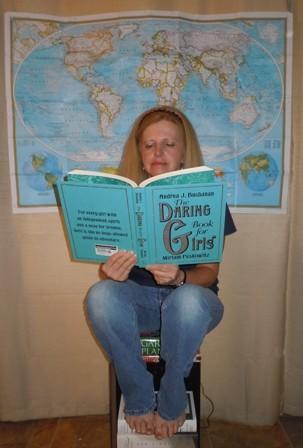Cheryl Hughes: Tell Me a Story
Recently, I saw an interview with Garrison Keillor (A Prairie Home Companion). One of the questions put to Keillor was what inspired him to go with radio during an era in which television had taken over as the essential medium for American entertainment. (Prairie Home Companion started its broadcast in the early 70’s and continues through today.) Keillor responded simply, “People like to be spoken to.”
I think he’s right. I’ve noticed that my granddaughter, Sabria, won’t sit still for long if one of us is reading to her, but she’ll sit forever if one of us is telling her a story. Like most three-year-olds, she has a vivid imagination, so I can only imagine what images go through her mind while she’s listening. She will stop the narrator at times in order to ask questions about the character’s actions or motives. She is trying to make sense of things by putting their experiences through the litmus test of her own knowledge and experiences.
Before she was two years old, Sabria would sit in the recliner with her Papa (Garey) and listen as he told her stories like “Little Red Riding Hood,” “Goldilocks,” and “The Three Little Pigs.” She became fascinated with the character of the Big Bad Wolf. Even today, she will run into the kitchen, and yell, “Hurry, Gee! It’s the Big Bad Wolf,” then grab my hand and usher me into the nearby bathroom, where she locks the door. I will say, “What are we going to do?” And she will respond, “He’s just pretend, Gee.”
I’ve often wondered if the great story-tellers of the past would have been story-tellers at all if they had grown up during the age of television; then again, they might have been screen writers. Many stories from the pre-movie era have been adapted for the screen—“A Christmas Carol,” “Silas Marner,” and “Romeo and Juliet.” Dickens, George Elliot, and Shakespeare would have probably still put their stamp of creative genius on humanity, but I wonder how many lesser known story-tellers we will never hear because they have been drowned out by or overwhelmed by our information-fueled society.
When my daughters were young, they loved to sit and listen to their grandmother, Agnes, recite poems and tell stories she was told as a child. My dad was one of the greatest story-tellers I’ve ever heard. His stories came from personal experience, with a “few” embellishments thrown in for good measure.
Lily Tomlin played a character on Broadway who said, “I can take reality in small doses, I just can’t handle it as a lifestyle.” I think story-telling is a reprieve from reality, a chance to go somewhere else, even if it is more frightening.
Story-telling can also serve as a teaching tool. Sabria has lots of curly hair that becomes easily tangled. I use a soft-bristled brush in order not to pull her hair, because she is so tender-headed. One morning, I discovered the brush wasn’t in the bathroom drawer where it is always kept. I remembered seeing her brushing her hair with it the night before.
“Do you know where your soft brush is?” I asked her, “I see you didn’t put it back where it belongs.”
“I not know where it is, Gee,” she replied.
“You know, if you don’t put your little soft brush back where he belongs, the brush monster might find him and gobble him up,” I told her.
“What’s the brush monster’s name?’ she asked
“Bristle,” I made up a name on the spot.
“What’s the little brush’s name?” she asked.
“Softy,” Garey said, as he walked into the room.
And thus began the tales of Princess Sabria, Softy and Bristle. Sabria never tires of hearing the story, and she has given me the chance to put my own creative stamp on her personal history.
- Log in to post comments



























